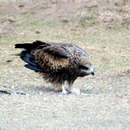Biology
(
الإنجليزية
)
المقدمة من Arkive
The migratory habits of the black kite are complex, but generally the populations at higher northern latitudes migrate southwards over winter, while those nearer the equator remain in the same area year round. This typically involves European populations moving south into sub-Saharan Africa and the Middle East, whilst populations north of Pakistan and the Himalayas travel into south Asia. Although populations closer to the equator, such as India, Australia, and central and southern Africa, tend to be sedentary, some do make small migrations in association with the seasons as well as in response to food supply and rainfall (4).
The hugely diverse range of food consumed by black kites varies from region to region and across the seasons. All types of carrion form an important part of this species' diet, but a notable variety of live prey, such as insects, reptiles, birds and small mammals, are also taken by this agile raptor. In urban environments, black kites are known to forage on human food scraps and garbage, and daringly steal food from market stalls and even people (4). Flocks of black kites are also commonly seen gathering around bush fires to pick off the hapless animals feeing the flames (6).
The black kite is an extremely gregarious species, particularly when feeding or roosting, with several thousand birds sometimes coming together in one area. Some pairs may breed solitarily but usually loose groups are formed, as is commonly seen in urban areas where nests may be made only a few metres apart. Aside from high circling, slow flapping and diving, the aerial displays during courtship are fairly limited but occasionally a pair will interlock talons in mid-air. The nests are built on tree branches, cliff ledges, pylons or buildings and are made from sticks and twigs lined with softer material, often comprised of rags and plastic (4). The typical clutch size is two to three eggs which are incubated by the female for around a month before hatching (4) (6). The young fledge after 42 -56 days and become independent another 15 to 50 days later (4).
Conservation
(
الإنجليزية
)
المقدمة من Arkive
Owing to its global ubiquity, the black kite is still classified as Least Concern on the IUCN Red List (1). Nonetheless, some early research has been conducted to assess habitat conservation priorities for the black kite in Europe, where the species is probably most threatened (7).
Description
(
الإنجليزية
)
المقدمة من Arkive
With a distribution that spreads over four continents, the black kite is probably the world's most abundant bird of prey. Not surprisingly for a species with such a colossal range, up to 12 subspecies have been described, with between six and eight commonly recognised (4). Despite their shared name, none of these subspecies are actually black, but rather have plumage that varies from moderate to dark brown, with irregular light-brown and rufous markings (4) (5). The brown to greyish-white head often appears paler than the rest of the body, while the cere (bare patch of skin at the base of the bill) is yellow (4) (6). Although the bill is typically black through most of its range, the African subspecies tend to have yellow bills, hence the species' alternative name. In flight, the long, shallow-forked tail is conspicuous and the feathers on the outer edge of the wings appear 'open fingered' (4) (5). The female is marginally larger than the male but otherwise the sexes are very similar, while the juveniles are only slightly paler and less uniform in colouration (4).
Habitat
(
الإنجليزية
)
المقدمة من Arkive
Given its immense range it is no surprise that the black kite occupies a wide variety of natural and artificial habitats from wetlands, river edges, savannah and woodland, to villages, towns and even big cities. Dense forest, pure deserts and high mountains are essentially the only habitats in which this species does not normally occur (2) (4).
Range
(
الإنجليزية
)
المقدمة من Arkive
The black kite is found through most of Africa, Europe and Asia (except for the Sahara, central China and the extreme north) and in parts of Indonesia, New Guinea and Australia (2) (4).
Status
(
الإنجليزية
)
المقدمة من Arkive
Classified as Least Concern (LC) on the IUCN Red List (1) and listed on Appendix II of CITES (3).
Threats
(
الإنجليزية
)
المقدمة من Arkive
Although still likely to be the world's most common raptor, the black kite is dwindling in parts of its range, particularly Europe and parts of Asia, as a result of agricultural pesticides, water pollution, carcass poisoning and hunting (4).

